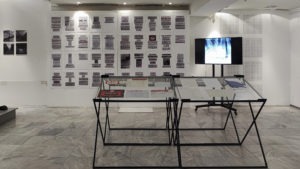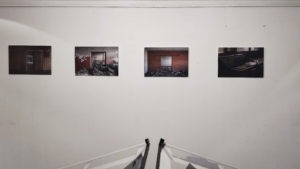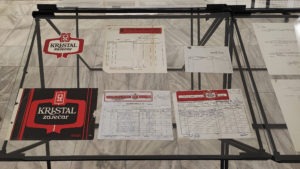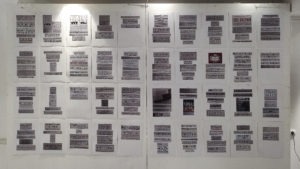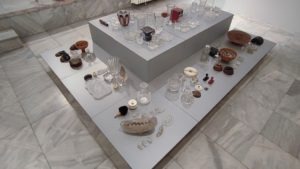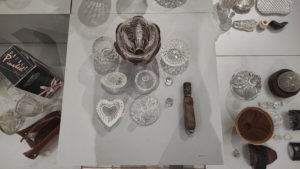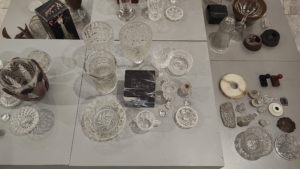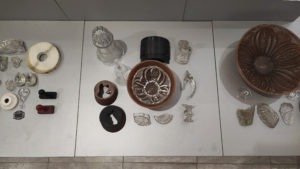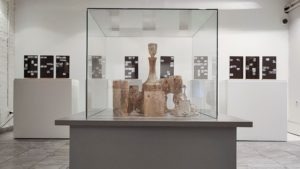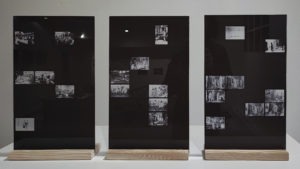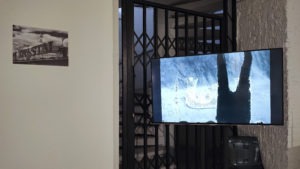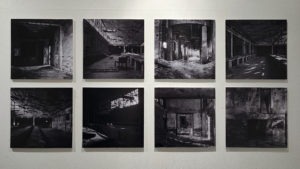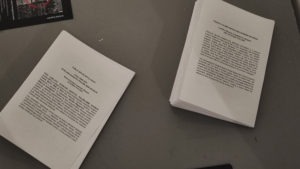EXHIBITION
FRAGILE: GLASS NARRATIVES, BROKEN HISTORIES
Museum of Applied Art, Belgrade
29.12.2022–15.01.2023
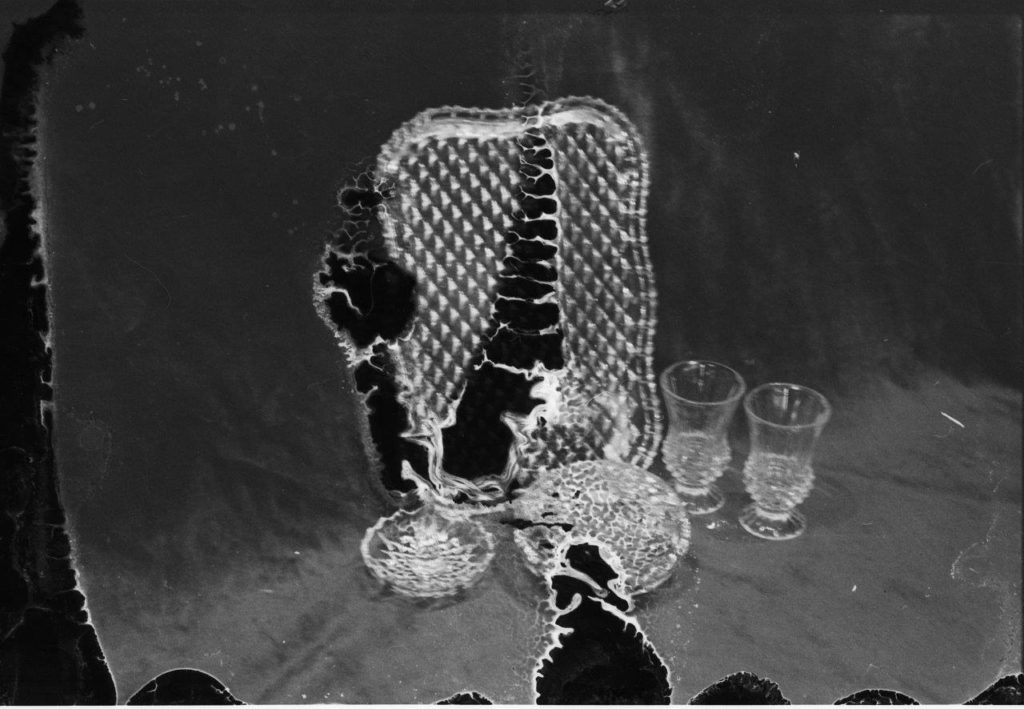
FRAGILE: GLASS NARRATIVES, BROKEN HISTORIES is a research project initiated by Public Space With A Roof, Amsterdam (Adi Hollander, Tamuna Chabashvili, Vesna Madžoski) in collaboration with SKVER Magazin, Zaječar, Serbia and photographer Mikica Andrejić. The project focuses on creating an archive and a collection of one of the former Yugoslav factory giants, Crystal-Zaječar, whose main goal was to turn previously luxurious objects of the rich into everyday objects available to everyone. After the 1990s and the fall of socialism, this factory which used to employ more than 4500 workers, was privatized and closed down. Nevertheless, the gigantic buildings it once occupied remained and still exist as strange creations seemingly belonging to an unknown civilization. The ‘archaeological’ research done by Public Space With A Roof brings the encounter with the world of broken objects, traces of broken lives, and evidence of a broken history. The exhibition in the museum juxtaposes the images from the past to the present ones, revealing the fragile nature of the archive and the collection assembled and studied. It shares the objects and information gathered during the research, creating a space where the visitors are able to explore this history on their own.
Until the end of the 1990s and the ‘collapse’ of socialism, Zaječar was known as a center of the Eastern region of Serbia. The town had more than a dozen factories – milk, textile, leather, fruit and vegetable, steel, glass, beer (the only remaining one currently owned by Heineken), etc. Each of them employed several thousands of people, something hard to imagine nowadays as they stand vacant today and in various stages of destruction. Mostly abandoned, waiting for decades to be privatized and sold, there are still traces of people and former production everywhere. In the meantime, many ‘vandals’ passed through, often destroying everything on their way but still leaving plenty behind: objects that seem not to have a place in history.
During one of their research visits to the former Crystal Factory, once famous worldwide, the group members of SKVER Magazin came across several hundreds of discarded photo negatives, covered in dirt and debris – a treasure nobody cared about. After cleaning and inspecting them, they were stunned to discover a forgotten world. As it turned out, many factories in former Yugoslavia used to have official photographers whose duty was to document the most important moments for the factory newspaper. Soon they discovered that the images document much more: workers during leisure time, doing sports, on trips and excursions, learning, or having fun. The images turned out to be silent witnesses of the slow decay of the factory as well: as the socialist system slowly collapsed, the images offered a glimpse into this process and struggles. The group spent the next several months digitizing and scanning them, searching for the data to identify the authors and times when they were taken.
United Nations have proclaimed 2022 to be the International Year of Glass, and soon an invitation for the collaboration came from the Museum of Applied Art in Belgrade. The UN proclamation further initiated a whole network of international institutions with the aim of creating various projects in 2022 and 2023 to promote the heritage of glass production worldwide. In order to offer a new reading of their archive-in-becoming as well as a different perspective on this history, SKVER Magazin invited Amsterdam-based artists’ initiative Public Space With A Roof, whose research projects deal with the new forms of exhibition making. During PSWAR research in Zaječar, it became clear this was also one of the unique opportunities to study a historical site that seems to exist outside of time: the space once occupied by the factory and its workers today speaks about the heritage not yet accepted by any of the existing narratives, existing in a particular state of limbo. PSWAR research project hence focused on using this opportunity and searching for the ways in which it becomes possible to make visible what is now invisible and formulate narrative(s) in which this particular history would be allowed to exist.
Our individual narratives were challenged and put into a dialogue with the narrative created by somebody else – the creator(s) of the found thousands of images from the photo negatives. The wild imagination, which was let to roam freely over the former factory spaces, has now been directed by this. On the other hand, during our theoretical research and reflection on this experience, we were constantly encountering pairs of seemingly conflicting dualities such as: liquid/solid, symmetry/asymmetry, darkness/light, fragile/indestructible, present/past, luxury/mass production, socialism/capitalism, humans/objects, negatives/positives, individual/collective, visible/invisible, presence/absence, etc. Hence our main idea for this project was to expose all those pairs and put them in a dialectical, productive relation to producing new narratives. The main dialectical pair we focused on was that of workers and objects. The fragility of human bodies became juxtaposed with the idea of the eternal nature of crystal objects that will survive the physical presence of their makers. This idea came from our studies of the very nature of glass as a material. Namely, although all those objects were worked on by a series of people (shaped by someone’s breath, touched by someone’s hands…), all traces of human labor became invisible in the final product itself.
For this exhibition, we printed the images from the black&white negatives discovered in the factory on glass plates. Referencing the early projection machines but also bringing to life the projections of faces and bodies of all the people who made the factory what it was. The exhibition also includes the photo archive of the photographer Mikica Andrejić who has been documenting the transformation of factory spaces in the past decade. This way, our exhibition includes not only the images of the life of the factory as it is to be found on the photo negatives but also the images of the absence of life.
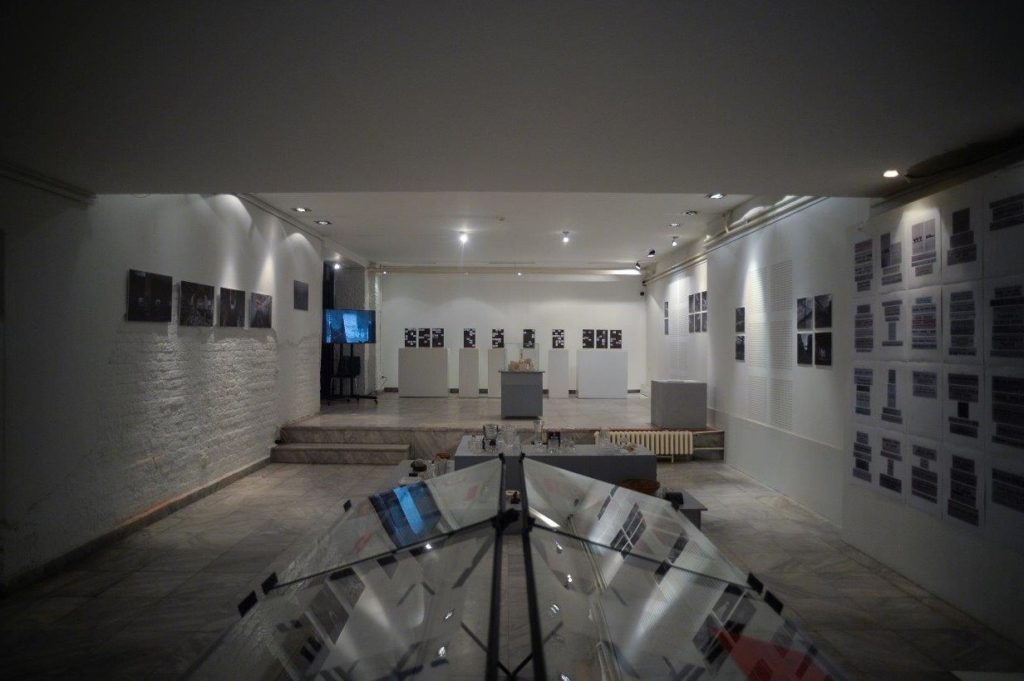
Special thanks to: Claudio Baroni, Tom Pinnegar, Ana and Guust Augustijn, Ceca and Ivan Atanasković, Dragana Živković, Matična biblioteka “Svetozar Marković” Zaječar, Jagodin and Dalibor Stankov, Damir Mihajlović, Nebojša Todorović, Negoslav Petković Neša, Jelena Cocović, Miljan Petrović “Overprint” Niš, Zoran Mojsin, Dejan Lalić, Lazar Leković, Čedomir Živanović.
The research was kindly supported by Mondriaan Fonds, Amsterdam.
SKVER Magazin was initiated in 2018 by Vesna Madžoski (professor of critical theory) and Mikica Andrejić (photographer) as a reaction to the current political and social conditions in the city which used to number more than 50.000 inhabitants only a decade ago, with more than 15 factories, and a developed public space – an image that is hardly recognizable anymore. There are no more than 20.000 inhabitants today, most factories were “privatized”, i.e. closed down, and new employment options are found abroad, in Slovakia or Alaska. Public spaces have been destroyed, from the green market to City Radio and TV station (whose estate was privatized and sound & video archive lost and destroyed). The name SKVER comes from the informal name for the main square in town, hence the idea was to create a new public space in which citizens would be able to meet and communicate again. The main form in which this was formalized so far was a website and social media presence since February 2019 at www.skvermagazin.com. SKVER initiated the ambitious project of digitizing and preserving cultural heritage of Timok Valley Region. By relying on enthusiasm and volunteer work, 12 years of newspaper Timok, once the main newspaper of the Timok Valley Region, were digitized and more than 4700 digitized pages are now available online. In 2020, SKVER digitized more than 10.000 images from found photo negatives of two former factory-giants: Crystal Factory, and Leather and Textile Industrial Complex “Zaječar” which are all now available online. On invitation by Zaječar Initiative and Foundation Step Forward, SKVER created content for the website Discover Zaječar. The research focused on history of Zaječar important buildings, monuments, locations and the website is to be accessed via a QR code attached on the featured buildings, informing tourists and local citizens on the urban history of Zaječar.
Public Space With A Roof (www.pswar.org) is an artists’ initiative founded in Amsterdam in 2003. It is a collaboration of the artists Tamuna Chabashvili (Georgia, 1978) and Adi Hollander (Belgium, 1976), and theoretician Vesna Madzoski (Serbia, 1976). Since 2004, PSWAR has produced large-scale projects, blurring the borders between various roles artists are assumed to take today: artists-as-activists, artists-as-producers, or artist-as-curators. PSWAR projects are research-based and address various questions central in current art production: the possibility for collaboration and collective action, development of new exhibition formats, creation of platforms for the intimate and individual experience of artworks, the use of others’ artworks as ready-mades, and the possibilities for sensory activation of the spectators through changed parameters of the space. The essential part of each project is an installation, which functions as a public space, a framework for the whole project, and an open laboratory. Here, different artworks, theories, and ideas are encountered and viewed from new perspectives, reflecting the questions posed at the beginning of the project and simultaneously rejecting the position of closed and final answers.
